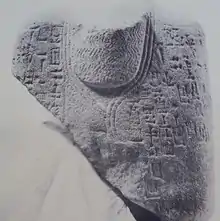| Ibbit-Lim | |
|---|---|
 Fragmentary torso of Ibbit-Lim | |
| King of Ebla | |
| Reign | around 1950 BCE |
| Father | Igrish-Kheb |
Ibbit-Lim was the earliest known ruler of the Third kingdom of Ebla, in modern Syria, reigning most likely shortly before 1950 BCE.[1]
Reign
Ibbit-Lim is only known by a fragmentary basalt torso found in 1968 at Tell Mardikh and now in Aleppo, which was part of a votive statue for Ishtar, once placed in this goddess' temple in the acropolis of Ebla.[2] A cuneiform inscription on it bears the name of the meki (king) of Ebla Ibbit-Lim, son of Igrish-Kheb, and claims that the statue was made "eight years after Ishtar's apparition in Ebla". It is believed that this text passage refers to the election of Ishtar as the poliadic goddess of Ebla, an action most likely brought by Ibbit-Lim himself, eight years before making the statue.[3]
Ibbit-Lim's torso was the first evidence permitting the identification of Tell Mardikh with the ancient city of Ebla, whose location had been lost.[4][5]
As one of the earliest rulers – if not the first one – of the Third kingdom of Ebla, Ibbit-Lim may have been the king who ordered the construction of city walls.[3] The names of Ibbit-Lim and his father Igrish-Kheb – who is not known to have been a king[3] – are Amorite, suggesting that the inhabitants of Third kingdom of Ebla were predominantly Amorites, as were most of the inhabitants of Syria at that time.[6]
Sources
- ↑ Matthiae (2010), p. 214
- ↑ Matthiae (2010), p. 281
- 1 2 3 Matthiae (2010), pp. 230-31
- ↑ Hans Gustav Güterbock; K. Aslihan Yener; Harry A. Hoffner; Simrit Dhesi (2002). Recent Developments in Hittite Archaeology and History. p. 25. ISBN 9781575060538.
- ↑ Joan Aruz (2013). Cultures in Contact: From Mesopotamia to the Mediterranean in the Second Millennium B.C. p. 103. ISBN 9781588394750.
- ↑ Giovanni Pettinato (1991). Ebla, a new look at history. p. 22. ISBN 9780801841507.
- Matthiae, Paolo (2010). Ebla. La città del trono (in Italian). Einaudi. ISBN 978-88-06-20258-3.